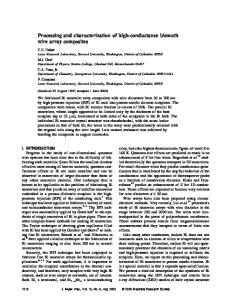Characterization of Renewable Composites
- PDF / 420,581 Bytes
- 6 Pages / 612 x 792 pts (letter) Page_size
- 73 Downloads / 350 Views
Characterization of Renewable Composites A. Emekalam, X. Gu, and D. Raghavan Polymer Division, Department of Chemistry, Howard University Washington DC 20059. ABSTRACT In this study, we demonstrate the usefulness of chemical based method in combination with AFM to characterize a wide range of degradable polymer blends. This approach is based on selective degradation of one of the phase in a multi-phase system and the ability of TMAFM to provide nanoscale lateral information about the different phases in the polymer system. Composite films containing different percentage of hydrolyzable polymer were either melt processed/solution casted and then exposed to a hydrolytic acidic environment and analyzed using TMAFM. Pits were observed to form in the blend films. The progressive hydrolysis of the hydrolyzable component in the composite was studied by FTIR analyses. TMAFM phase imaging was used to follow pit growth of the blend as a function of exposure time. The usefulness of the chemical modification/AFM approach in the characterization of renewable porous material membranes is discussed. INTRODUCTION For many applications such as filtration membrane, packaging, agricultural mulch film, degradable escape hatches for lobster pots, and nursery pots, the long lasting properties of polymeric material are not desired; instead a polymer with a predetermined lifetime is required. To address the degradability of the conventional polymeric material, researchers have substituted a major portion of the non-degradable polymer by degradable renewable polymer (i.e. starch, poly lactic acid, polyhydroxy butyrate) and/or hydrolyzable synthetic polymer (i.e. polyvinyl alcohol, polyethylene acrylate) (1-4). The lifetime of renewable polymer in a degradable environment may be hours, but when placed in a nondegradable matrix, its lifetime increases from hours to months, depending on the degradable polymer concentration and the hydrolyzing environment (5,6). The longevity of the degradable blends is also defined by the interactions between film and its external environment, which in turn is influenced by the surface chemistry and morphology of the blend film. In recent years, extensive research has been conducted to characterize the morphology of films using analytical techniques such as scanning electron microscopy, and X-ray photoelectron spectroscopy (7-8). However, characterization of certain polymeric films by these techniques does not provide the lateral resolution at nanoscale level. With AFM, it is possible to provide direct spatial mapping of surface topography and surface heterogeneity at nanometer resolution. Phase-separated regions in blend have been mapped based on the topographic image contrast (9), or on phase image contrast (10-12), or on compositional analysis (13) or on the use of force curve measurements (12). Recently, we showed that the assignment of the domain and matrix regions of a U7.1.1
multiphase blend by physical method is not always possible (14-15), instead chemicalbased method can be highly useful. In this p
Data Loading...











